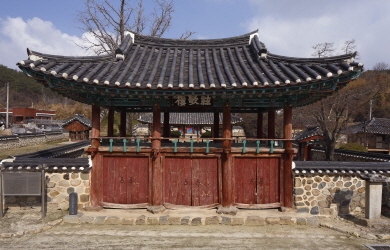Stories of Korea’s nine seowon
Introduction to 9 seowon, UNESCO World Heritage Sites
The center of efforts to harmonize sarim and hyangchonMuseongseowon Jeongeup (Historic Site No. 166)
Museongseowon, located in Jeong-up, Jeollabuk-do, was founded in 1615 by local literati to honor the accomplishments of Choe Chi-won (857-?),
a bureaucrat and scholar of the Unified Silla Kingdom.
All sound files
Important functions of seowon
- Outline
- Veneration
- Learning
- Interaction
- Other aspects
Outline
Museongseowon, located in Jeong-up, Jeollabuk-do, was founded in 1615 by local literati to honor the accomplishments of Choe Chi-won (857-?), a bureaucrat and scholar of the Unified Silla Kingdom.

Scenery of Museongseowon
Choe Chi-won, known as one of the “three great writers of Silla” together with Kang Su and Seolchong, was familiar with Confucianism, Buddhism, Taoism, and the philosophy of Lao Tzu. Seven years after going to Tang China at the age of 13, Choi passed the civil service examination (taking first place). He first became famous for his “Manifesto to Huang Chao,” which was written in 879. After returning to Silla at the age of 29, Choi served as the governor of various prefectures. When he left his post as the governor of Taesan (today’s Jeong-eup), locals were so sorry to see him go that they built a “living shrine” (shrine built to honor a living person) in recognition of his benevolent character. This shrine was moved in 1483 to the hyanghakdang built by Jeong Geuk-in and renamed “Taesansa,” according to the name of its original home.
Later, literati of the Taesan area built a living shrine for Governor Shin Jam. In 1615, the living shrines for Choi and Shin and the hyanghakdang were combined into “Taesanseowon.” Taesanseowon became a royally sponsored seowon in 1696 when King Sukjong bestowed a name board inscribed with the name “Museongseowon.”
Later, literati of the Taesan area built a living shrine for Governor Shin Jam. In 1615, the living shrines for Choi and Shin and the hyanghakdang were combined into “Taesanseowon.” Taesanseowon became a royally sponsored seowon in 1696 when King Sukjong bestowed a name board inscribed with the name “Museongseowon.”
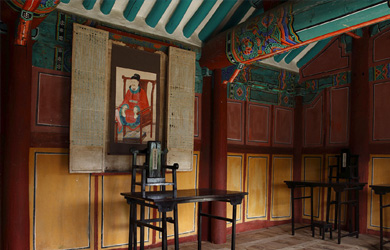
Taesansa
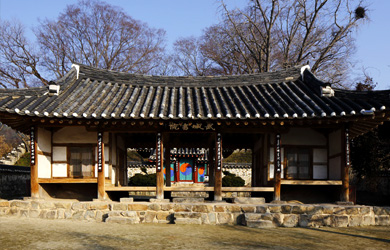
Myeongnyundang
Hyeongaru
Museongseowon is a representative seowon of southwestern Korea that cultivated many literati during the Joseon dynasty. Museongseowon’s regulations outline the goals and content of seowon education as well as the educational methodologies used. Everyone was welcome to come and learn, regardless of age or social class. There were several things about which the seowon was very strict, however. Students always had to keep their appearance neat, be loyal to one another, and make academic progress. Many texts were taught, including Yi Yi’s Gyeokmongyogyeol and the basic Confucian texts: Elementary Learning, Great Learning, Mencius, The Analects, Doctrine of the Mean, Book of Odes, Book of Changes, Book of Rites, and Spring and Autumn Annals.
Museongseowon is a group of simple, unassuming buildings that is located in a town at the foot of a low mountain. The seowon is surrounded by the village’s houses—showing a break from most seowon, which are constructed in areas with beautiful natural features. The location of Museongseowon suggests that it prioritized what is in a person’s heart and mind rather than outward appearances and attached great value to intellectuals’ social role and responsibility to enhance the quality of life of their community. This unique stance resulted in the seowon’s buildings being mostly open to local residents, rather than closed off.
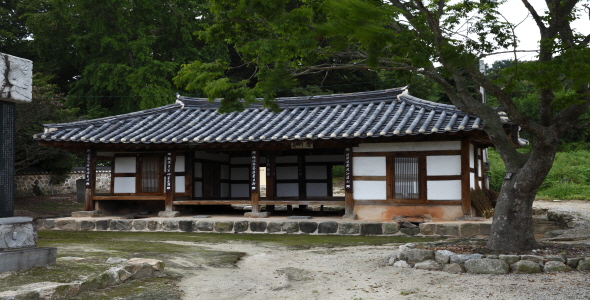
Gangsujae
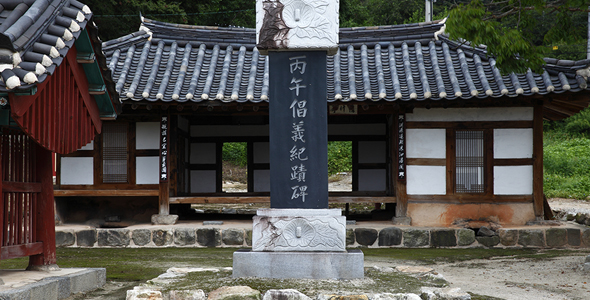
Commemorative stele honoring the uibyeong
The three-door main gate, Hyeongaru, doubled as a pavilion where students could go to relax. After passing through Hyeongaru, one arrives at Myeongnyundang, the main lecture hall. This structure is an open, wall-less area that consists only of a three-kan floor and a roof propped up with pillars. Contrary to the learning spaces of other seowon, the dormitory (Gangsujae) is not positioned in front of Myeongnyundang but outside of the seowon wall. After going behind Myeongnyundang and entering the taegeuk-designed, three-pronged gate of the shrine, one is faced with the shrine itself: Taesansa. It is a rare example of a shrine that honored living people.
There is a commemorative stele in the right-hand side of the courtyard outside Museongseowon dedicated to the approximately 80 literati who joined forces with the uibyeong to resist the encroaching Japanese in the early 20th century.
Museongseowon is notable not only for its positive academic influence on the local community but also its willingness to live in harmony with its neighbors and join patriotic endeavors when called upon.
There is a commemorative stele in the right-hand side of the courtyard outside Museongseowon dedicated to the approximately 80 literati who joined forces with the uibyeong to resist the encroaching Japanese in the early 20th century.
Museongseowon is notable not only for its positive academic influence on the local community but also its willingness to live in harmony with its neighbors and join patriotic endeavors when called upon.
Veneration at Museongseowon
At Museongseowon, the path that was taken to carry ritual objects from the main gate to the shrine is lined on both sides with clay. The clay indicates that the space in between is the “path that the gods tread on.” Another purpose of the clay was to keep negative energy away from the ritual objects. All utensils and foods required for a ritual were carried by two people from the main gate, along the clay path, past the center kan of the learning area, and through the center door of the shrine.
The Chunchuhyangsa of Museongseowon, unlike those of other seowon, which displayed only the spiritual tablets of the enshrined, was unique in that Choe Chi-won’s portrait was displayed as well.
The Chunchuhyangsa of Museongseowon, unlike those of other seowon, which displayed only the spiritual tablets of the enshrined, was unique in that Choe Chi-won’s portrait was displayed as well.

Naesammun
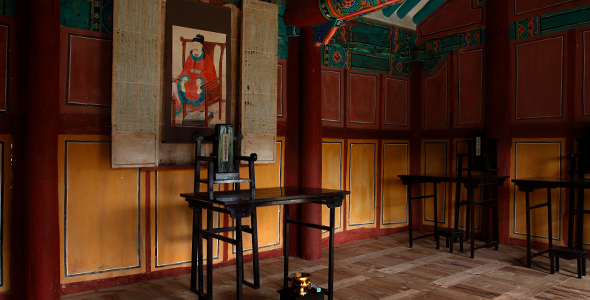
Inside Taesansa
Venerated individuals
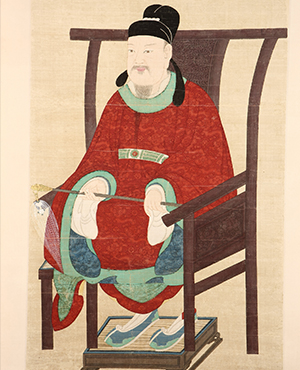
Portrait of Choe Chi-won
The individuals enshrined at Museongseowon are: Choe Chi-won, Jeong Geuk-in (1401-1481), Song Se-rim (1479-?), Shin Jam (1491-1554), Jeong Eon-chung (1706-1772), Kim Yak-muk (1500-1558), and Kim Kwon (1549-1662). All were sarim scholars and bureaucrats who lived or worked in Jeong-eup and actively taught Neo-Confucianism in their local community. Their efforts to improve society and bring about tangible change through Neo-Confucianism are valuable even today. The selection of the individuals enshrined at Museongseowon is based on a different set of criteria from other seowon, which focused more on the individual’s accomplishments in Neo-Confucianism study.
Learning at Museongseowon
The regulations of Museongseowon explain the seowon’s goal as follows: “to achieve progress in reading and learning to open the mind, see clearly, and act morally.” The regulations also state that the purpose of studying is to “gain virtue so that one becomes a worthy person.” Therefore, students at Museongseowon were required to concentrate on their studies and live in harmony with their peers and teachers regardless of social class. If there was anyone who did not live in this way, he was strictly disciplined. For example, a student received 60 lashes if he could not recite from memory what he learned the previous day, 70 lashes if he played Chinese go or any other type of “degenerate” game, and 100 lashes if he chased women.
Museongseowon’s prioritizing of virtue in order to become a good human being over academic learning gives us a lot to think about in terms of the true meaning of education.
Museongseowon’s prioritizing of virtue in order to become a good human being over academic learning gives us a lot to think about in terms of the true meaning of education.

Myeongnyundang
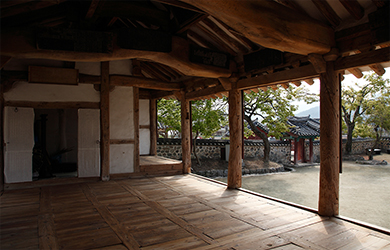
Inside Myeongnyundang
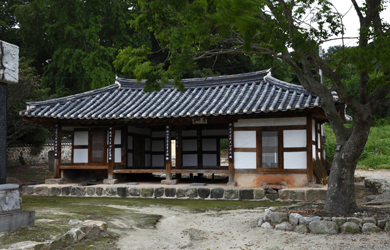
Gangsujae
Interaction at Museongseowon
Hyeongaru, the pavilion at Museongseowon, was named after the fact that Confucius never stopped playing the geomungo or singing, no matter the circumstances (絃歌不輟). Such naming of a seowon building suggests that the message for students was to never abandon their studies, no matter how difficult things may get.

Hyeongaru
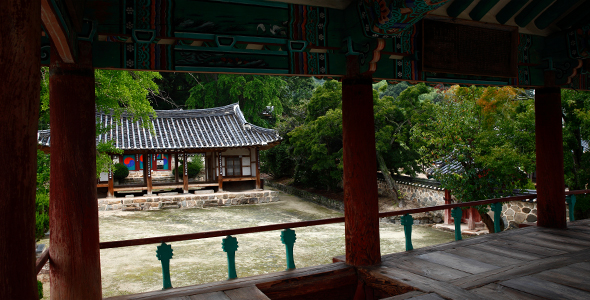
Inside Hyeongaru

